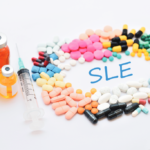A phase 3 clinical trial in which researchers treated lupus patients with blisibimod, a biologic treatment that inhibits B cell activating factor (BAFF), did not meet its primary endpoint, but did demonstrate evidence of possible efficacy.
Researcher Joan T. Merrill, MD, a member of the Oklahoma Medical Research Foundation (OMRF) and OMRF professor of medicine at the University of Oklahoma, says that in a previous phase 2 clinical trial of this treatment, it appeared the sickest subset of patients benefited from treatment. The phase 3 trial, therefore, was enriched for patients with more disease activity, she says. The study’s objective was to evaluate the safety and efficacy of blisibimod in this more acutely ill population, including some patients with stable nephritis.
Phase 3 trials of more than 4,000 systemic lupus erythematosus (SLE) patients have evaluated targeted BAFF inhibitors in past years. “BAFF, also known as BLyS, is key in activating and prolonging survival and differentiation of B cells,” Dr. Merrill says. Analyses of these past studies tended to identify greater treatment effects in patients entering with higher disease activity, greater corticosteroid doses, anti-double-stranded DNA (anti-dsDNA) antibodies and low complement C3 or C4.

Dr. Merrill
This randomized, double-blind, placebo-controlled trial of blisibimod evaluated 442 patients with SLE. The patients received weekly subcutaneous blisibimod (200 mg) or placebo and were encouraged to taper their corticosteroids from Week 8. Those given blisibimod generally tolerated it well. The most common adverse events were typical for lupus trials, including upper respiratory and urinary tract infections, injection-site reactions and gastrointestinal disorders. The trial did not meet its primary endpoint of SRI-6, which requires a six-point reduction on the SLED Disease Activity Index (SLEDAI) without meaningful increases in two other measures. Nevertheless, the study revealed some indications of possible treatment efficacy. More blisibimod-treated subjects were able to taper their corticosteroids to </= 7.5 mg/day prednisone or equivalent, which was statistically significant at all timepoints after Week 24. There was also an increase in the SRI-6 treatment difference when only those who had achieved the steroid taper milestone were considered (P=0.056).
In those who entered the study with a urinary protein:creatinine ratio (UpCr) of ≥56.5 mg/mmol (500 mg/gm), a significantly higher proportion of blisibimod-treated subjects achieved >50% reduction, which was statistically significant at multiple timepoints. Reductions in SLE autoantibodies and increases in complement C3 and C4 were also observed with blisibimod.
Blisibimod is a peptibody (constructed to contain elements of a peptide and an antibody) that targets both membrane-bound and circulating BAFF. Belimumab (Benlysta), which also targets BLyS, binds only its circulating form. In lupus, inflammation is like a vicious circle, Dr. Merrill says. “Something triggers type I interferons to be made, and these, along with other triggers, induce the production of BAFF, which is appreciated to be a central player in the classic B cell pathology in lupus,” she says. “Then the inflammation that results from BAFF activity goes around to promote more type I interferons to be made.” BAFF (BLyS) inhibitors attempt to interrupt this flow.


